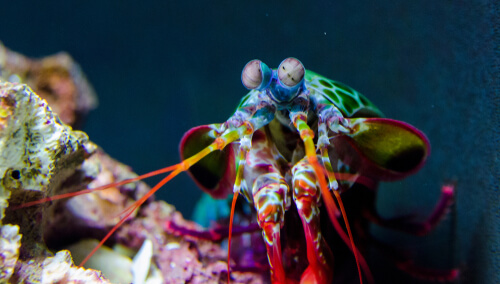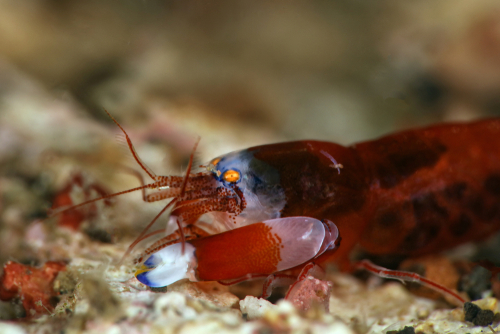Mantis Shrimp vs. Pistol Shrimp: Which Is Best?
Posted by on 2/07/2023
We use affiliate links and may receive a small commission on purchases.
If you're looking to add a unique species to your saltwater aquarium, both Mantis Shrimp and Pistol Shrimp have a lot to offer. While both are referred to as "shrimp", Mantis Shrimp are technically stomatopods, small creatures that roam the subtropical waters of the Indian and Pacific Oceans.
Pistol Shrimp are descendants of the Pleocyemata suborder , making them true shrimp by definition . These shrimp possess a unique characteristic: a pistol-like claw that the species uses to shoot jets of water at potential prey. Sounds interesting? It is, and in this post, we're going to give you everything you'll need to help decide which species is best for you.
January's Giveaways on Light Fish
Mantis Shrimp
Mantis Shrimp are stomatopods with a rich history. These carnivorous animals have interacted with humans as early as the 21st century BC, when ancient Assyrians referred to them as sea locusts .
They are a carnivorous species, and have roamed the earth for over 193 million years! . Mantis Shrimp are divided into quite a few distinct groups, but the most common are named after the types of claws that these shrimp possess.
Smashers are Mantis Shrimp that have developed a club-like appendage, which they use to smash and bludgeon their meals.
Spearers are Mantis Shrimp with a barbed, spear-like appendage, which they use to skewer soft animals, such as fish.
Both types of Mantis Shrimp can be found in saltwater tanks, but hobbyists should heavily consider whether or not they want to dedicate an aquarium solely to these animals. Due to their hunting ability and diet, they are not compatible with most aquarium fish and should only be kept as a single species, or with other Mantis Shrimp.

Appearance
Mantis Shrimp have a striking appearance. A slender carapace is covered in small Pleopods and Uropods, small appendages that the Shrimp uses for swimming and backward movement. Their eyes can see up to 15 different pigments of color, seeing in both the ultraviolet and infrared spectrums, and their raptorial appendages, which sit below the antennas, are used to catch and consume prey.
Hobbyists looking to own one of these species may look for the more affordable Lime Green Mantis Shrimp (scientific name: Gonodactylaceus viridis) or Peacock Mantis (scientific name: Odontodactylus scyllarus), the latter known for its rainbow coloration.
Care
Mantis Shrimp should be kept by themselves in a saltwater aquarium and should be provided water conditions similar to other marine invertebrates.
Aim for the following water parameters:
Temperature: 72-78°F
Salinity: 1.023 - 1.025
dKH: 8-12
pH: 8.1-8.4
Nitrates should be kept as close to 0 as possible.
Feeding
Mantis Shrimp should be fed small snails, mollusks, and raw shrimp at least once a day.
You'll want to chop the food up into small bits, so that excess food doesn't rot along the substrate and pollute the water column.
Pistol Shrimp
Pistol Shrimp are invertebrates that are members of the Alpheidae family. Their defining feature is their regenerative large claw, which is capable of producing a powerful bubble wave that is so strong it can break glass!
They're known for their mutualistic relationship with Goby Fish, which involves sharing a sand burrow. The burrow is constructed by the Pistol Shrimp and then guarded by the Goby Fish. This unique relationship can be recreated in a home aquarium and is one of the reasons why the species is so popular.
Growing to about 2 inches in length, most Pistol Shrimp can be found living along the tropical and temperate coasts, where they produce snapping noises so loud they can interfere with sonar .
Appearance
There are a few species of Pistol Shrimp that are common in the saltwater aquarium hobby, and they are the Tiger Pistol Shrimp, and Japanese Snapping Shrimp. Tiger Pistols have an orange and white color pattern, while Japanese Snapping Shrimp have translucent bodies covered in red and white stripes.
Their most defining feature, their claw-like appendage known as the pistol, is so large it can grow to reach half the length of the Pistol's body.

Care
Pistol Shrimp are known to be quite reclusive, and will rarely present themselves unless you plan on pairing them with a Goby. They're capable of making loud noises in an aquarium and are known to dig holes throughout the sand bed.
If you're up for the challenge, you'll want to maintain the following water conditions:
Temperature: 72-78°F
Salinity: 1.023 - 1.025
dKH: 8-12
pH: 8.1-8.4
Similar to Mantis Shrimp, low nitrates are important when keeping these interesting invertebrates.
Feeding
Pistol Shrimp are carnivores and should be fed Sinking Carnivore Pellets at least once a week.
These shrimp will also eat frozen crustaceans, such as krill and Mysis shrimp, and will even share food with a Goby fish if one is present in the aquarium.
Best Choice for Hobbyists on a Budget
Hobbyists looking for the most affordable option between Mantis Shrimp and Pistol Shrimp should go with a single-species Lime Green Mantis Shrimp aquarium.
The Lime Green Mantis is affordable, averaging about $15-30 dollars. While Pistol Shrimp are slightly more expensive, we recommend pairing them with a Goby, which increases costs, making the Mantis Shrimp the more affordable option.
Best Choice for a Reef Tank
We recommend going with Pistol Shrimp in a reef tank. When paired with a Goby fish, Pistol Shrimp will spend most of their time building their burrows and creating small tunnels.
Pistol Shrimp do a great job at cleaning your sand bed, but be warned, they may occasionally pick up a small coral frag to cover their burrows!
Best Choice for a Non-Reef Tank
If you're looking to establish a saltwater aquarium without any corals or fish, go with a Mantis Shrimp.
Their aggressive personalities and unique appearance make them fascinating species to care for. Besides, who wouldn't want to own a species that is capable of defending itself against an Octopus?
Conclusion
As you can see, both Mantis Shrimp and Pistol Shrimp are interesting marine life forms with unique characteristics. With proper care, owning either of these species can be a rewarding experience, just don't be the person that lets these species fight each other for YouTube fame (unfortunately, there are a lot of these videos circulating the web.)
Now that you know about some of the differences between these two species, do you plan on adding one to your saltwater tank? Let us know in the comments, and be sure to check out our marketplace where you might be able to find one for sale, and our community forum where you can meet and discuss these species with other hobbyists.
January's Giveaways on Light Fish


